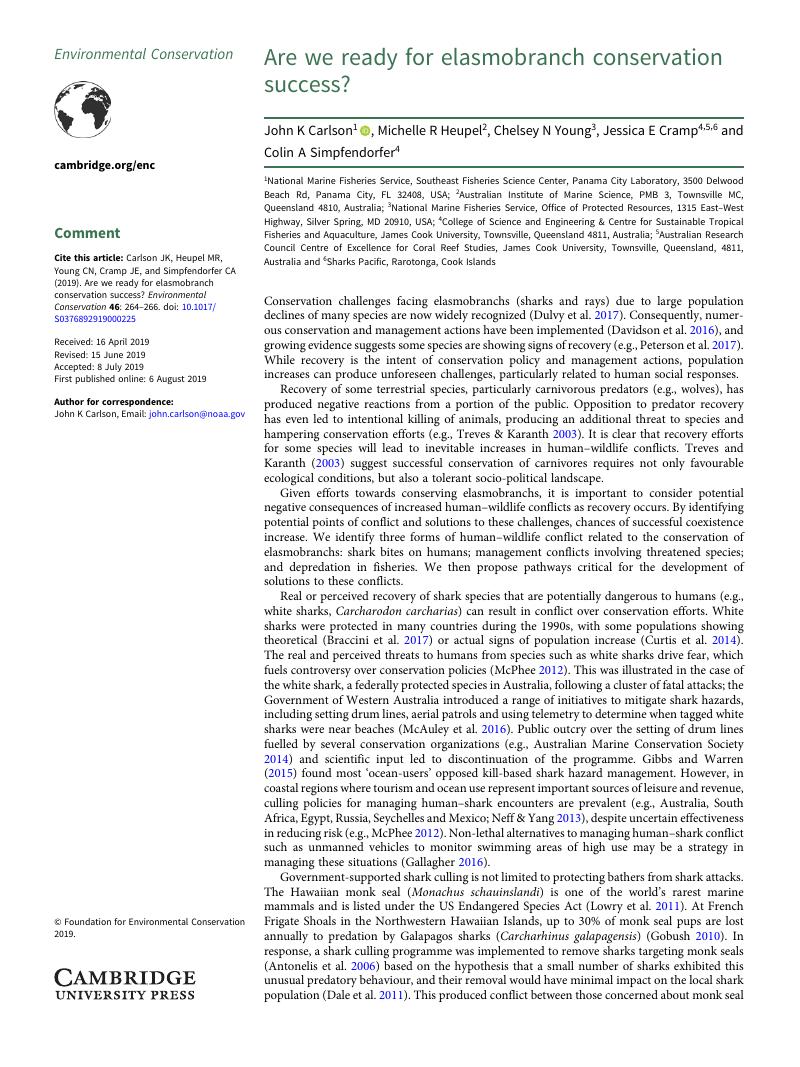Crossref Citations
This article has been cited by the following publications. This list is generated based on data provided by Crossref.
Drymon, J. M.
Dedman, S.
Froeschke, J. T.
Seubert, E. A.
Jefferson, A. E.
Kroetz, A. M.
Mareska, J. F.
and
Powers, S. P.
2020.
Defining Sex-Specific Habitat Suitability for a Northern Gulf of Mexico Shark Assemblage.
Frontiers in Marine Science,
Vol. 7,
Issue. ,
Muñoz-Baquero, Marta
Marco-Jiménez, Francisco
García-Domínguez, Ximo
Ros-Santaella, José Luis
Pintus, Eliana
Jiménez-Movilla, María
García-Párraga, Daniel
and
García-Vazquez, Francisco Alberto
2021.
Comparative Study of Semen Parameters and Hormone Profile in Small-Spotted Catshark (Scyliorhinus canicula): Aquarium-Housed vs. Wild-Captured.
Animals,
Vol. 11,
Issue. 10,
p.
2884.
Carmody, H
Langlois, T
Mitchell, J
Navarro, M
Bosch, N
McLean, D
Monk, J
Lewis, P
and
Jackson, G
2021.
Shark depredation in a commercial trolling fishery in sub-tropical Australia.
Marine Ecology Progress Series,
Vol. 676,
Issue. ,
p.
19.
Simpfendorfer, Colin A.
Heupel, Michelle R.
and
Kendal, Dave
2021.
Complex Human-Shark Conflicts Confound Conservation Action.
Frontiers in Conservation Science,
Vol. 2,
Issue. ,
Winton, Megan V.
Sulikowski, James
and
Skomal, Gregory B.
2021.
Fine-scale vertical habitat use of white sharks at an emerging aggregation site and implications for public safety.
Wildlife Research,
Vol. 48,
Issue. 4,
p.
345.
Matich, Philip
Plumlee, Jeffrey D.
and
Fisher, Mark
2021.
Grow fast, die young: Does compensatory growth reduce survival of juvenile blacktip sharks (Carcharhinus limbatus) in the western Gulf of Mexico?.
Ecology and Evolution,
Vol. 11,
Issue. 22,
p.
16280.
Giareta, Eloísa Pinheiro
Prado, Aline Cristina
Leite, Renata Daldin
Padilha, Érica
Santos, Ingrid Hyrycena dos
Wosiak, Caroline Da Costa De Lima
and
Wosnick, Natascha
2021.
Fishermen's participation in research and conservation of coastal elasmobranchs.
Ocean & Coastal Management,
Vol. 199,
Issue. ,
p.
105421.
Sills, Jennifer
Chapman, Demian D.
Ali, Khadeeja
MacNeil, M. Aaron
Heupel, Michelle R.
Meekan, Mark
Harvey, Euan S.
Simpfendorfer, Colin A.
and
Heithaus, Michael R.
2021.
Long-term investment in shark sanctuaries.
Science,
Vol. 372,
Issue. 6541,
p.
473.
Robinson, Danielle
Newman, Steven P.
Whittingham, Mark J.
Francksen, Richard M.
Adam, M. Shiham
and
Stead, Selina M.
2022.
Fisher–shark interactions: A loss of support for the Maldives shark sanctuary from reef fishers whose livelihoods are affected by shark depredation.
Conservation Letters,
Vol. 15,
Issue. 6,
Pepin-Neff, Christopher L.
2022.
Shark Bite Reporting and The New York Times.
Biology,
Vol. 11,
Issue. 10,
p.
1438.
Griffin, Lucas P.
Casselberry, Grace A.
Lowerre‐Barbieri, Susan K.
Acosta, Alejandro
Adams, Aaron J.
Cooke, Steven J.
Filous, Alex
Friess, Claudia
Guttridge, Tristan L.
Hammerschlag, Neil
Heim, Vital
Morley, Danielle
Rider, Mitchell J.
Skomal, Gregory B.
Smukall, Matthew J.
Danylchuk, Andy J.
and
Brownscombe, Jacob W.
2022.
Predator–prey landscapes of large sharks and game fishes in the Florida Keys.
Ecological Applications,
Vol. 32,
Issue. 5,
Casselberry, Grace A.
Markowitz, Ezra M.
Alves, Kelly
Dello Russo, Joseph
Skomal, Gregory B.
and
Danylchuk, Andy J.
2022.
When fishing bites: Understanding angler responses to shark depredation.
Fisheries Research,
Vol. 246,
Issue. ,
p.
106174.
Peterson, Cassidy D.
Wilberg, Michael J.
Cortés, Enric
Courtney, Dean L.
and
Latour, Robert J.
2022.
Effects of unregulated international fishing on recovery potential of the sandbar shark within the southeastern United States.
Canadian Journal of Fisheries and Aquatic Sciences,
Vol. 79,
Issue. 9,
p.
1497.
Peterson, Cassidy D.
Wilberg, Michael J.
Cortés, Enric
Courtney, Dean L.
and
Latour, Robert J.
2022.
Effects of Altered Stock Assessment Frequency on the Management of a Large Coastal Shark.
Marine and Coastal Fisheries,
Vol. 14,
Issue. 5,
Hoel, Kristin
Chin, Andrew
and
Lau, Jacqueline
2022.
Clashing conservation values: The social complexities of shark depredation.
Biological Conservation,
Vol. 272,
Issue. ,
p.
109658.
Wester, Julia
Turffs, Dylann
Shiffman, David
and
Macdonald, Catherine
2022.
‘A human values issue’: Actors, arguments, and regulatory change in the Florida land‐based shark fishery.
Aquatic Conservation: Marine and Freshwater Ecosystems,
Vol. 32,
Issue. 12,
p.
1953.
Mitchell, J. D.
Drymon, J. M.
Vardon, J.
Coulson, P. G.
Simpfendorfer, C. A.
Scyphers, S. B.
Kajiura, S. M.
Hoel, K.
Williams, S.
Ryan, K. L.
Barnett, A.
Heupel, M. R.
Chin, A.
Navarro, M.
Langlois, T.
Ajemian, M. J.
Gilman, E.
Prasky, E.
and
Jackson, G.
2023.
Shark depredation: future directions in research and management.
Reviews in Fish Biology and Fisheries,
Vol. 33,
Issue. 2,
p.
475.
Gilman, Eric
Chaloupka, Milani
Booth, Hollie
Hall, Martin
Murua, Hilario
and
Wilson, Jono
2023.
Bycatch-neutral fisheries through a sequential mitigation hierarchy.
Marine Policy,
Vol. 150,
Issue. ,
p.
105522.
Prasky, Evan Gerald
Drymon, J. Marcus
Karnauskas, Mandy
Anderson, Alena Q.
Gibbs, Sarah L.
Grabowski, Jonathan H.
Jargowsky, Amanda E.
McAree, Danielle M.
Osowski, Ana R.
Swinea, Savannah H.
and
Scyphers, Steven B.
2023.
Depredation influences anglers’ perceptions on coastal shark management and conservation in the United States Gulf of Mexico.
Frontiers in Conservation Science,
Vol. 4,
Issue. ,
Winton, MV
Fay, G
and
Skomal, GB
2023.
An open spatial capture-recapture framework for estimating the abundance and seasonal dynamics of white sharks at aggregation sites.
Marine Ecology Progress Series,
Vol. 715,
Issue. ,
p.
1.



